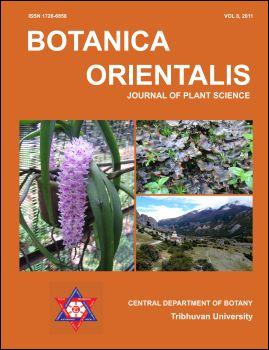Epiphytic cyanobacterial diversity in the sub-Himalayan belt of Garhwal region of Uttarakhand, India
DOI:
https://doi.org/10.3126/botor.v8i0.5955Abstract
Cyanobacteria constitute the largest, most diverse and widely distributed group of prokaryotes that perform oxygenic photosynthesis. These are known to comprise a diverse flora of morphologically distinct forms. Some species are epiphytic occurring on a variety of plants. The present study was undertaken to study the distribution pattern of epiphytic cyanobacterial flora in the foot-hills of Garhwal Himalaya. An extensive survey was carried out in different seasons at four cyanobacteria-rich localities (Dakpatthar, Kotdwar, Rishikesh and Laldhang) of Uttarakhand state of India. A total of 39 epiphytic cyanobacterial taxa (12 heterocystous and 27 non-heterocystous) belonging to 2 orders, 7 families and 17 genera were recorded from this region. Highest number of species (25) was reported from Rishikesh, followed by Kotdwar with 14 species and Laldhang and Dakpatthar each with 12 species. Principal Component Analysis showed significant variation for epiphytic cyanobacterial diversity among studied sites, whereas cluster analysis categorized epiphytic cyanobacterial diversity under two categories, viz. Cluster I with 9 species and Cluster II with 30 species. Study concludes that variation in epiphytic cyanobacterial diversity might be compared to physicochemical properties of soil and climatic conditions along altitudes.
doi: http://dx.doi.org/10.3126/botor.v8i0.5955
Botanica Orientalis – Journal of Plant Science (2011) 8: 77-89
Downloads
Downloads
Published
How to Cite
Issue
Section
License
This license enables reusers to copy and distribute the material in any medium or format in unadapted form only, for noncommercial purposes only, and only so long as attribution is given to the creator.




